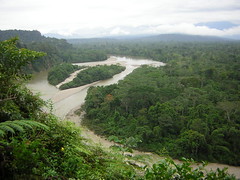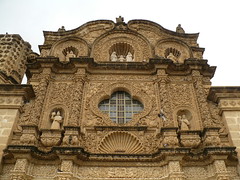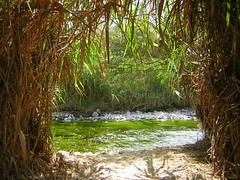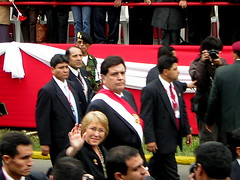Between the two neighbouring administrative areas of Maranga and Sulcovilca was Limatambo. Once a busy town surrounded by fields, only two structures still exist on the edge of San Isidro and in La Victoria.
Category: "Archaeology"
Lord of Ucupe: “King of Bling” Tomb Sheds Light on Ancient Peru [Featured]
I wrote some time ago about the stunning archaeological find at a dig led by Canadian Steve Bourget of the University of Texas. Here is the follow-up by National Geographic News:
Huaca Huantille
The Huaca Huantille was one of countless archaeological sites lost among the urban sprawl of Lima, forgotten and neglected. That was until Francis Allison, mayor of the district of Magdalena del Mar where the pyramidal structure is located, decided to try to restore it along with the run down neighbourhood it is located in.
Parque de las Leyendas, zoo and ruins
Parque de las Leyendas, a zoo built among the ruins of a pre-Inca city, somehow manages to mix ecology and archaeology, attracting hundreds of Peruvian families each day. Off the usual tourist trail for foreigners, it could make a good half-day trip and is a great chance to learn about Peru’s rich biodiversity and about Lima’s ancient past.
Huaca Huallamarca
In the heart of lush residential San Isidro, the Huaca Huallamarca is one of dozens of pre-Columbian sites found within the city of Lima – a densely populated area even then. Heavily restored and open to tourists, the pyramid sits surrounded by huge modern penthouses that are a stark and unusual contrast for such an ancient ruin.
Los Ñaupa
They existed in a time before our time, in a world that existed before ours. These beings inhabited the planet long before us and were called the Ñaupa by the indigenous peoples of the central Andes.
Their earth was different from ours. There were no bright days or dark nights, just an ambient glow and a steady temperature. When this began to change and the great Inti, the sun god, brought night and day to the world, the Ñaupa retreated to the tallest mountains to dwell within them.
Paredones, Nazca
The Incas also arrived in the Nazca plains, albeit about 1000 years after the Nazca culture faded from existence. The people of these desert valleys still lived as they once did, maintaining the irrigation canals of their ancestors and producing textiles of similar quality with similar patterns. After being dominated by the Wari they were accustomed to the idea of foreign rule and submited to the Incas easily.
Lost ruins of Kantupata
One of the steepest slopes delays us enough to observe the immensity of the view, and while the wind almost blows us off the mountain, we discover that before our eyes Machu Picchu is in view… but from an angle we have never seen before, not even in photos. The view is, how can I say, from behind. It is really stunning to behold.
Kantupata announces itself with a grand stairway of stone, which once cleaned-up by the archaeologists is truly impressive.
We continued on to a place that has particular impact. A large plaza with a shrine in the centre, surrounded by buildings and walls. Below, with a view of the peaks in the distance, more stone farming terraces unfold, parallel with water fountains similar to those at Wiñay Huayna.
Huacas of Manchay Alto
There’s not much left of it now, but there is something special about this temple complex in the Lurín valley that makes it so interesting. At about 3000 years old, it makes the city of Pachacamac just to the southwest look positively modern.
Wari city unveiled in Cerro Pátapo – missing link discovered
In less than two weeks since work began, amazing discoveries have been made at the Cerro Pátapo archaeological site, until now little more than a pile of rocks. This huge site that stretches over 5km is now revealing its importance – it is a missing link between the declining Moche culture and the newly arrived Wari.
The Nazca Civilisation
Descended from the older Paracas civilisation, the Nazca are of course most famous for their countless mysterious lines draw in the rocky desert plains in which they lived. They were also great water engineers, creating a series of complex aqueducts.
Maria Reiche
…Tirelessly, she spent day after day of her life under the hot sun cleaning rocks from lines, and working on her theories as to what they were for. She for one came to the conclusion that the lines were some kind of calendar, marking solstices and the passage of stars and constellations…







![Potato Planting in Chinchero [Featured]](http://farm4.static.flickr.com/3198/2687152654_97a0cc29fb_m.jpg)


